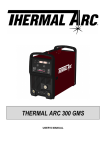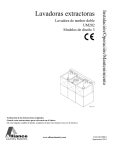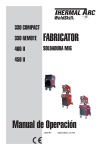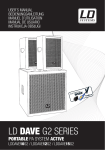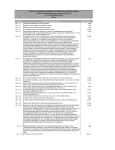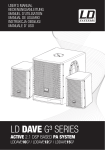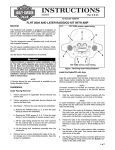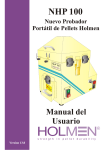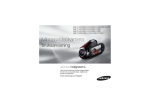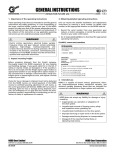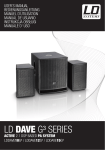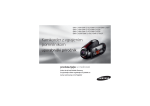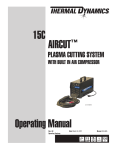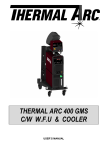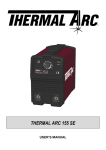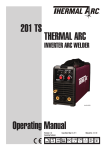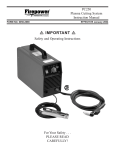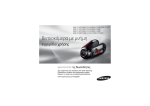Download Thermal arc 170-220 GMS notice technique NOT077-r04
Transcript
THERMAL ARC 170 GMS THERMAL ARC 220 GMS USER’S MANUAL The machine you have just acquired has taken advantages, in its production, of Thermal Arcs' wide experience in the manufacturing of welding machines, along with the latest technology strides in power electronics. It will give you entire satisfaction for years if you respect all the operating and maintenance instructions given in this manual. We strongly suggest you read very carefully chapters concerning safety and individual protection before using this machine. We thank you in advance for your co-operation. THERMADYNE INDUSTRIES reserve the right to make changes without previous notification. Illustrations, descriptions and characteristics are not contractually binding and do not engage the responsability of the manufacturer. USER’S MANUAL Page 2/30 THERMAL ARC 170 GMS THERMAL ARC 220 GMS Notice NOT 077 Rev : 04 Date 15/10/2009 TABLE OF CONTENTS WARRANTY POLICY STATEMENT ........................................................................................... 5 SAFETY....................................................................................................................................... 6 1. ELECTROMAGNETIC COMPATIBILITY ................................................................................................................6 1.1. DECLARATION OF CONFORMITY ......................................................................................................................6 1.2. INSTALLATION AND USE.....................................................................................................................................6 1.2.1. ASSESSMENT OF AREA ...................................................................................................................................................7 1.2.2. METHODS OF REDUCING EMISSIONS..........................................................................................................................7 1.2.2.1. Public supply system.........................................................................................................................................................7 1.2.2.2. Maintenance of the arc welding equipment.......................................................................................................................7 1.2.2.3. Welding cables..................................................................................................................................................................7 1.2.2.4. Equipotential bonding .......................................................................................................................................................7 1.2.2.5. Earthing of the workpiece .................................................................................................................................................8 1.2.2.6. Screening and shielding ....................................................................................................................................................8 2. 3. ELECTRIC SAFETY.......................................................................................................................................................8 2.1. CONNECTION OF THE WELDING POWER SOURCE TO THE NETWORK ....................................................8 2.2. WORKING AREA.....................................................................................................................................................8 2.3. INTERVENING.........................................................................................................................................................9 2.4. MAINTENANCE.......................................................................................................................................................9 2.5. RISKS OF FIRE AND EXPLOSION ........................................................................................................................9 INDIVIDUAL PROTECTION........................................................................................................................................9 3.1. RISK OF EXTERNAL INJURIES.............................................................................................................................9 3.1.1. 3.1.2. THE WHOLE BODY ...........................................................................................................................................................9 FACE AND EYES..............................................................................................................................................................10 3.2. RISK OF INTERNAL INJURIES............................................................................................................................10 3.3. SAFETY IN THE USE OF GASES (welding with TIG or MIG inert gases) .........................................................11 3.3.1. 3.3.2. 3.3.3. COMPRESSED GAS CYLINDERS ..................................................................................................................................11 PRESSURE RELIEF VALVE............................................................................................................................................11 DETAILS ABOUT GASES................................................................................................................................................11 DESCRIPTION .......................................................................................................................... 12 4. GENERAL CHARACTERISTICS...............................................................................................................................12 5. TECHNICAL CHARACTERISTICS ..........................................................................................................................13 SETTING UP ............................................................................................................................. 14 6. CONNECTION TO THE MAIN SUPPLY...................................................................................................................14 USER’S MANUAL Page 3/30 THERMAL ARC 170 GMS THERMAL ARC 220 GMS Notice NOT 077 Rev : 04 Date 15/10/2009 TABLE OF CONTENTS 7. CONNECTION TO THE GROUND ............................................................................................................................14 8. PRELIMINARY PRECAUTIONS ...............................................................................................................................14 USING........................................................................................................................................ 15 9. DESCRIPTION OF THE FRONT PANEL..................................................................................................................15 10. DESCRIPTION OF THE BACK PANEL ................................................................................................................16 11. MMA (STICK) WELDING..........................................................................................................................................16 12. TIG WELDING ..........................................................................................................................................................17 13. MIG WELDING .........................................................................................................................................................18 13.1. PREPARATION FOR WELDING WITH THE MIG TORCH ...........................................................................18 13.2. PREPARATION FOR WELDING WITH THE SPOOL GUN ...........................................................................19 13.3. ADJUSTMENT OF THE PARAMETERS..........................................................................................................19 14. SPOT MIG WELDING..............................................................................................................................................20 15. INTERMITTENT MIG WELDING.........................................................................................................................20 MAINTENANCE ........................................................................................................................ 22 16. MAINTENANCE .......................................................................................................................................................22 17. SPARE PARTS ...........................................................................................................................................................22 18. TROUBLE SHOOTING ............................................................................................................................................26 19. WIRING DIAGRAMS ...............................................................................................................................................27 APPENDICE .............................................................................................................................. 29 20. APPENDICE : ADJUSTABLE VALUES FOR WELDING PARAMETERS ......................................................29 USER’S MANUAL Page 4/30 THERMAL ARC 170 GMS THERMAL ARC 220 GMS Notice NOT 077 Rev : 04 Date 15/10/2009 WARRANTY POLICY STATEMENT In accordance with the warranty periods stated below, Thermadyne guarantees the proposed product to be free from defects in material or workmanship when operated in accordance with the written instructions as defined in this operating manual. Thermadyne welding products are manufactured for use by commercial and industrial users and trained personnel with experience in the use and maintenance of electrical welding and cutting equipment. Thermadyne will repair or replace, at its discretion, any warranted parts or components that fail due to defects in material or workmanship within the warranty period. The warranty period begins on the date of sale to the end user. Thermal Arc 170 - 220 GMS Component Warranty Period Power Source 2 Years Optional Remote Controls 6 Months If warranty is being sought, Please contact your Thermadyne product supplier for the warranty repair procedure. Thermadyne warranty will not apply to: • • • • • Equipment that has been modified by any other party other than Thermadyne’s own service personnel or with prior written consent obtained from Thermadyne Service Department. Equipment that has been used beyond the specifications established in the operating manual. Installation not in accordance with the installation/operating manual. Any product that has been subjected to abuse, misuse, negligence or accident. Failure to clean and maintain (including lack of lubrication, maintenance and protection), the machine as set forth in the operating, installation or service manual. Within this operating manual are details regarding the maintenance necessary to ensure trouble free operation. This manual also offers basic troubleshooting, operational and technical details including application usage. You may also wish to visit our web site www.thermadyne.com select your product class and then select literature. Here you will find documentation including: • • • Operator manuals Service manuals Product guides Alternatively please contact your Thermadyne distributor and speak with a technical representative. NOTE Warranty repairs must be performed by either a Thermadyne Service Centre, a Thermadyne distributor or an Authorised Service Agent approved by the Company. September 2009 USER’S MANUAL Page 5/30 THERMAL ARC 170 GMS THERMAL ARC 220 GMS Notice NOT 077 Rev : 04 Date 15/10/2009 SAFETY The equipment you have just acquired will give you entire satisfaction if you respect the operating and maintenance instructions. Its design, the specification of the components and its manufacture are in accordance with the existing rules, French standards (NF), ISO and CEI international injunctions, EEC general lines and CEN/CENELEC standards. In this chapter, you will find safety rules in the use of electric arc welding power sources with coated electrodes. We give you hereunder a list of recommendations and obligations you have to respect. Safety rules must be observed, and particularly those relating to Decree 88.1056 dated November 14., 1988 concerning protective measures against electrical currents. 1. ELECTROMAGNETIC COMPATIBILITY 1.1. DECLARATION OF CONFORMITY THERMADYNE Industries hereby declare that the machine object of this manual complies with the following European regulations: Electromagnetic compatibility: Rule 89/336-EEC of 3/05/89 modified by rules 92/31-EEC of 28/04/1992 and 93/68-EEC of 22/07/1993. Low voltage: Rule 73/23-EEC of 19/02/1973 modified by rule 93/68-EEC of 22/07/1993. and with the national legislation transposing them. THERMADYNE Industries also declare that following harmonised standards have been applied : EN 50199 (1995): Electromagnetic compatibility (CEM) – Product norm for arc welding material. EN 50060 (1990): Current source for arc manual welding with limited service. EN 60974-1: Security rules for electric welding material. Part 1: welding current sources. EN 50192 (1995): Arc welding material – plasma cutting systems. 1.2. INSTALLATION AND USE The machine object of this manual complies with the European regulations about electromagnetic compatibility 89/336 CEE. It also complies with EN 50199 standard: Electromagnetic compatibility, product standard for welding machines. The user is responsible for installing and using the arc welding equipment according to the manufacturer’s instructions. If electromagnetic disturbances are detected, then it shall be the responsibility of the user of the arc welding equipment to resolve the situation with the technical assistance of the manufacturer. In some cases this remedial action may be as simple as earthing the welding circuit, see Note. In other cases it could involve USER’S MANUAL Page 6/30 THERMAL ARC 170 GMS THERMAL ARC 220 GMS Notice NOT 077 Rev : 04 Date 15/10/2009 SAFETY constructing an electromagnetic screen enclosing the welding power source and the work complete with associated input filters. In all cases electromagnetic disturbances shall be reduced to the point, where they are no longer troublesome. NOTE - The welding circuit may or may not be earthed for safety reasons. Changing the earthing arrangements should only be authorised by a person who is competent to assess whether the changes will increase the risk of injury, e.g. by allowing parallel welding current return paths, which may damage the earth circuits of other equipment. Further guidance is given in IEC 62081 "Arc welding equipment - Installation and use" (under consideration). 1.2.1. ASSESSMENT OF AREA Before installing arc welding equipment the user shall make an assessment of potential electromagnetic problems in the surrounding area. The following shall be taken into account : a) Other supply cables, control cables, signalling and telephone cables, above, below and adjacent to the arc welding equipment; b) Radio and television transmitters and receivers; c) Computer and other control equipment; d) Safety critical equipment, e.g. guarding of industrial equipment, e) The health of the people around, e.g. the use of pacemakers and hearing aids; f) Equipment used for calibration or measurement; g) The immunity of other equipment in the environment. The user shall ensure that other equipment being used in the environment is compatible. This may require additional protection measures; h) The time of day that welding or other activities are to be carried out. The size of the surrounding area to be considered will depend on the structure of the building and other activities that are taking place. The surrounding area may extend beyond the boundaries of the premises. 1.2.2. METHODS OF REDUCING EMISSIONS 1.2.2.1. Public supply system Arc welding equipment should be connected to the public supply system according to the manufacturer’s recommendations. If interference occurs, it may be necessary to take additional precautions such as filtering of the public supply system. Consideration should be given to shielding the supply cable of permanently installed arc welding equipment, in metallic conduit or equivalent. Shielding should be electrically continuous throughout its length. The shielding should be connected to the welding power source so that good electrical contact is maintained between the conduit and the welding power source enclosure. 1.2.2.2. Maintenance of the arc welding equipment The arc welding equipment should be routinely maintained according to the manufacturers recommendations. All access and service doors and covers should be closed and properly fastened when the arc welding equipment is in operation. The arc welding equipment should not be modified in any way, except for those changes and adjustments covered in the manufacturer’s instructions. In particular, the spark gaps of arc striking and stabilising devices should be adjusted and maintained according to the manufacturer’s recommendations. 1.2.2.3. Welding cables The welding cables should be kept as short as possible and should be positioned close together, running at or close to the floor level. 1.2.2.4. Equipotential bonding Bonding of all metallic components in the welding installation and adjacent to it should be considered. USER’S MANUAL Page 7/30 THERMAL ARC 170 GMS THERMAL ARC 220 GMS Notice NOT 077 Rev : 04 Date 15/10/2009 SAFETY However, metallic components bonded to the work piece will increase the risk that the operator could receive an electric shock by touching these metallic components and the electrode at the same time. The operator should be insulated from all such bonded metallic components. 1.2.2.5. Earthing of the workpiece Where the workpiece is not bonded to earth for electrical safety, nor connected to earth because of its size and position, e.g. ships hull or building steelwork, a connection bonding the workpiece to earth may reduce emissions in some, but not all instances. Care should be taken to prevent the earthing of the workpiece increasing the risk of injury to users, or damage to other electrical equipment. Where necessary, the connection of the workpiece to earth should be made by a direct connection to the workpiece, but in some countries where direct connection is not permitted, the bonding should be achieved by suitable capacitance, selected according to national regulations. 1.2.2.6. Screening and shielding Selective screening and shielding of other cables and equipment in the surrounding area may alleviate problems of interference. Screening of the entire welding installation may be considered for special applications. 2. ELECTRIC SAFETY 2.1. CONNECTION OF THE WELDING POWER SOURCE TO THE NETWORK Before connecting your equipment, you must check that: -The meter, the safety device against over-currents, and the electric installation are compatible with the maximum power and the supply voltage of the welding power source (refer to the instructions plates). -The connection, either single-phase, or three-phase with earth can be effected on a socket compatible with the welding power source cable plug. If the cable is connected to a fixed post, the earth, if provided, will never be cut by the safety device against electric shocks. -The ON/OFF switch (if exists) situated on the welding power source, is turned off. 2.2. WORKING AREA The use of arc welding implies a strict respect of safety conditions with regard to electric currents (Decree dated 14.12.1988). It is necessary to check that no metal piece accessible to the operators and to their assistants can come into direct contact with a phase conductor and the neutral of the network. In case of uncertainty, this metal part will be connected to the earth with a conductor of at least equivalent section to the largest phase conductor. Make sure that all metal pieces that the operator could touch with a non insulated part of his body (head, hands without gloves on, naked arms ...) is properly grounded with a conductor of at least equivalent section to the biggest supply cable of the ground clamp or welding torch. If more than one metal ground are concerned, they need to be all interlinked in one, which must be grounded in the same conditions. Unless very special care has been taken, do not proceed with any arc welding or cutting in USER’S MANUAL Page 8/30 THERMAL ARC 170 GMS THERMAL ARC 220 GMS Notice NOT 077 Rev : 04 Date 15/10/2009 SAFETY conductive enclosures, whether it is a confined space or the welding machine has to be left outside. Be even more prudent when welding in humid or non ventilated areas, and if the power source is placed inside (Decree dated 14.12.1988, Art. 4). 2.3. INTERVENING -Before carrying out any internal checking or repair work, check that the power source has been separated from the electrical installation by locking and guard devices. -The current plug has to be taken out. Provisions have to be taken to prevent an accidental connection of the plug to a socket. -Cut-off through a fixed connecting device has to be omnipolar (phases and neutral). It is in the "OFF" position and cannot be accidentally put into operation. -Maintenance works of electrical equipment must be entrusted to qualified people (Section VI, Art. 46). 2.4. MAINTENANCE Check the good state, insulation and connection of all the equipment and electrical accessories: plugs and flexible supply cables, cables (NF A 32-510), conduits, connectors, extension cables (NF A 85-610 and CENELEC HD 433), sockets on the power source, ground and electrode-holder clamps (NF A 85-600). These connections and mobile accessories are marked according to standards, if consistent with the safety rules. They can either be controlled by you or by accredited firms. - Maintenance and repair works of conduits and liners have to be properly carried out (Section VI, Art. 47). -Repair or replace all defective accessories -Check periodically that the electrical connections are tightened and do not heat. 2.5. RISKS OF FIRE AND EXPLOSION Welding can occur risks of fire or explosion. You have to pay attention to fire safety regulation - Remove flammable or explosive materials from welding area. - Always have sufficient fire fighting equipment - Fire can break out from sparks even several hours after the welding work has been finished. 3. INDIVIDUAL PROTECTION 3.1. RISK OF EXTERNAL INJURIES 3.1.1. THE WHOLE BODY Arc rays produce very bright ultra violet and infra red light. They will damage yours eyes and burn your skin if you are not properly protected -The welder is dressed and protected according to the constraints his works impose him. -Insulate yourself from the workpiece and the ground. Make sure that no metal piece, especially those connected to the network, can come into contact with the operator. -The welder must always wear an individual insulating protection (decree of 14/12/1988, article 3-3). Protective clothing : gloves, aprons, safety shoes offer the additional advantage to protect the operator against burns caused by hot pieces and spatter. This protective equipment should be kept in good order and checked on a regular basis. USER’S MANUAL Page 9/30 THERMAL ARC 170 GMS THERMAL ARC 220 GMS Notice NOT 077 Rev : 04 Date 15/10/2009 SAFETY 3.1.2. FACE AND EYES -.It is absolutely necessary to protect your eyes against arc rays. - Protect your hair and your face against sparks The welding shield, with or without headset, is always equipped with a proper filter according to the arc welding current (NS S 77-104 / A 88-221 / A 88.222 standards). In order to protect shaded filter from impacts and sparks, you have to add a plain glass in front of the shield. The helmet provided with your equipment (if requested) is equipped with a protective filter. When you want to replace it, precise the reference and number of opacity degree of the filter. Use the shade of lens as recommended in the instruction manual (opacity graduation number) Protect others in the work area from arc rays by using protective booths, UV protective goggles, and if necessary, a welding shield with appropriate protective filter on (NF S 77-104 - by A 1.5). Opacity gradation numbers and recommended use for arc welding Current intensity in Amps Welding process or connected techniques 0.5 2.5 1 10 5 20 15 40 30 80 60 125 175 225 275 350 450 100 150 200 250 300 400 500 Coated electrodes 9 10 11 12 MIG on heavy metals 10 11 12 MIG on light alloys 10 11 12 13 TIG on all metals 9 10 11 12 13 14 MAG 10 11 12 13 Air/Arc gouging 10 11 12 13 Plasma cutting 9 10 11 12 13 Depending on the conditions of use, the next highest or lowest category number may be used. The expression “heavy metals” covers steels, alloyed steels, copper and its alloys. The shaded areas represent applications where the welding processes are not normally used at present. CARE : 3.2. 13 13 14 14 14 14 14 15 15 15 Use a higher degree of filters if welding is performed in premises which are not well lighted. RISK OF INTERNAL INJURIES GASES AND FUMES Gases fumes produced during the welding process can be dangerous and hazardous to your health. Arc welding works have to be carried out in suitable ventilated areas. Ventilation must be adequate to remove gases and fumes during operation. All fumes produced during welding have to be removed as soon as they are given off, and as close as possible from the place they are produced to be the most efficient. Vapors of chlorinated solvents can form the toxic gas phosgene when exposed to ultraviolet radiation from an electric arc. USER’S MANUAL Page 10/30 THERMAL ARC 170 GMS THERMAL ARC 220 GMS Notice NOT 077 Rev : 04 Date 15/10/2009 SAFETY 3.3. SAFETY IN THE USE OF GASES (WELDING WITH TIG OR MIG INERT GASES) 3.3.1. COMPRESSED GAS CYLINDERS Compressed gas cylinders are potentially dangerous. Refer to suppliers for proper handling procedures. - No impact: secure the cylinders and keep them away from impacts. - No excess heat (over 50°C) 3.3.2. PRESSURE RELIEF VALVE Check that the pressure relief screw is slackened off before connecting to the cylinder. Check that the union is tight before opening the valve of the cylinder. Open it slowly a fraction of a turn. If there is a leak, NEVER tighten a union which is under pressure, but first close the valve on the cylinder. Always check that hoses are in good condition. 3.3.3. DETAILS ABOUT GASES Gas and gaseous mixtures containing less than 20% of CO2: If these gases or mixtures take the place of the oxygen in the air, there is a danger of asphyxia. An atmosphere containing less than 17% oxygen is dangerous. hydrogen and hydrogen-based combustible gaseous mixtures These are very light gases. In the case of leaks, they collect under the ceiling. Provide for ventilation at ceiling level. These are also inflammable gases. The flame of hydrogen is almost invisible. There is therefore a risk of burns. Air/hydrogen and oxygen/hydrogen mixtures are explosive in the following proportions: - 4 to 74.5 % of hydrogen in air. - 4 to 94 % of hydrogen in oxygen. Store the bottles in the open or in a well-ventilated place. Avoid any leakage by limiting the number of connections or couplings to a minimum. USER’S MANUAL Page 11/30 THERMAL ARC 170 GMS THERMAL ARC 220 GMS Notice NOT 077 Rev : 04 Date 15/10/2009 DESCRIPTION 4. GENERAL CHARACTERISTICS The single phase power sources THERMAL ARC 170 GMS and 220 GMS have been designed as integrated and portable units using the latest techniques in power electronics, based on an IGBT controlled inverter process, which enables the following : - a considerable reduction of weight and volume - the dynamic control of the welding current - a high power in a small space at a very low power consumption With their innovative design, these machines are both robust (plastic front and back panel, new internal conception) and ergonomic. The THERMAL ARC 170 GMS and 220 GMS units are multiprocess DC inverters wich allow : - MMA welding (stick welding) : with coated electrodes until 4 mm (170 GMS) or 5 mm (220 GMS) - TIG welding : with infusible electrodes . Ignition made with PAE (« lift arc ») process. 2 stroke or 4 stroke mode Post gas adjustment Down-slope time adjustment Gas purge - MIG welding : wire feeder built in 15 kgs spools steel wire, stainless steel wire of diameter 0.6 mm to 1.0 mm (170 GMS) or 1.2 mm (220 GMS) direct or reverse polarity of the wire 2 stroke or 4 stroke mode Post gas adjustment Cold wire inch Burn-back adjustment Inductor linear adjustment Spot MIG welding : with adjustment of the spot’s time Intermittent MIG welding : with adjustment of the spot’s time and of their frequency. These power sources offer exceptional arc stability. Easy to use, they can be adjusted exactly to your need : - They have a linear electronic inductor, wich allows total variation of the arc (soft or hard) and limits the amount of spatter. - They have adjustable burn back wich allows the adjustment of the wire’s length after the torch’s head at the end of the welding. They are perfectly suited to the MIG welding with aluminium wire. USER’S MANUAL Page 12/30 Notice NOT 077 THERMAL ARC 170 GMS THERMAL ARC 220 GMS Rev : 04 Date 15/10/2009 DESCRIPTION 5. TECHNICAL CHARACTERISTICS DIMENSIONS (in mm) PRIMARY Single phased power supply Frequency Maximum primary current Maximum power consumption Power factor (cos Ø) Primary protection THERMAL ARC 170 GMS V Hz A kVA THERMAL ARC 220 GMS 230 50 / 60 MMA TIG MIG MMA TIG MIG 23 5.3 14.1 3.2 22.6 5.2 33 7.5 21 4.8 32.4 7.5 0.98 A 16 20 SECONDARY Off load voltage Welding current range V A Welding current at 40°C Welding current at 15 % Welding current at 20 % Welding current at 35 % Welding current at 60 % Welding current at 100 % A A A A A Welding current at 25°C Welding current at 60 % Welding current at 100 % A A Protection degree Insulation class Standards Weight Dimensions L x W x H MMA TIG MIG MMA TIG MIG 50-60 3 à 150 15 3 à 150 15 - 80 3 à 200 15 3 à 200 15 - 170 150 110 100 200 160 140 200 170 150 220 200 170 150 150 105 95 150 110 100 130 120 180 160 IP 23 H EN 60974-1 / EN 50199 19 570 x 279 x 460 kg mm USER’S MANUAL Page 13/30 THERMAL ARC 170 GMS THERMAL ARC 220 GMS Notice NOT 077 Rev : 04 Date 15/10/2009 SETTING UP 6. CONNECTION TO THE MAIN SUPPLY The power source must be connected to a single-phase 230V - 50 Hz/60 Hz mains + ground. Main supply must be protected by fuses or circuit-breaker according to the value I1eff written on the specifications of the power source. It is strongly suggested to use a differential protection for the operator’s safety 7. CONNECTION TO THE GROUND For the operator's protection, the power source must be correctly grounded (according to the International Protections Norms). It is absolutely necessary to provide a good ground connection installation with the green/yellow lead of the power cable. This will avoid discharges caused by accidental contact with grounded pieces. If no earth connection has been set, a high risk of electric shock through the chassis of the unit remains possible. 8. PRELIMINARY PRECAUTIONS For the good operation of your welding power source, make sure that the air flow produced by the fan inside the unit is not obstructed. Also try to operate in a non-dusty area. Avoid all impacts, exposure to damp areas or excessive temperatures. USER’S MANUAL Page 14/30 THERMAL ARC 170 GMS THERMAL ARC 220 GMS Notice NOT 077 Rev : 04 Date 15/10/2009 USING 9. DESCRIPTION OF THE FRONT PANEL ITEM F1 F2 F3 F4 F5 F6 F7 F8 F9 F10 F11 DESCRIPTION Knob for intensity, wire speed and parameters Knob for voltage and down-slope time ITEM F12 Knob for linear inductor Setting key « gaz purge or cold wire inch » Burn-back adjustment Setting key for selecting 2 stroke or 4 stroke welding mode, intermittent MIG welding or spot MIG welding Setting key for selecting welding mode Overheat indicator « gaz purge or cold wire inch » indicator Burn-back in adjustment indicator « intermittent MIG welding » indicator or « time between two spots » in adjustment indicator « spot MIG welding » indicator or « spot’s time » in adjustment indicator Indicator « 4 stroke welding » F14 F15 DESCRIPTION « TIG welding » indicator or TIG post gaz in adjustment indicator « MIG welding » indicator or MIG post gaz in adjustment indicator « MMA welding » indicator Power terminal + F16 Power terminal - F17 F18 F19 Torch’s polarity connection Torch’s EURO connector Female socket for connecting the spool gun Switch « wire feeder built in » or « spool gun » F13 F20 USER’S MANUAL Page 15/30 THERMAL ARC 170 GMS THERMAL ARC 220 GMS Notice NOT 077 Rev : 04 Date 15/10/2009 USING 10. DESCRIPTION OF THE BACK PANEL ITEM B1 B2 DESCRIPTION Switch ON/OFF Gas input 11. MMA (STICK) WELDING Connect the power source to the main supply and the ground as explained in the chapter « Setting up » (as para 6 and 7). Connect the ground cable and the electrode-holder to the appropriate power connections + F15 and – F16 according to the electrode polarity being used (refer to the electrodes manufacturer’s datasheets). The “torch’s polarity connection” F17 is not connected. Start up the power source with the main switch ON/OFF B1. Select MMA(stick) welding mode with the setting key F6, the indicator F14 illuminates. Adjust welding current with potentiometer F1. Note: For THERMAL ARC 170 GMS unit, the welding current can be adjusted until 150A maximum. The graduation between 150A to 200A is not available. Place the electrode on the piece you have to weld in order to strike the arc. Arc force control Arc force control is not adjustable, but it is optimised for welding with a large range of rutile and basic electrodes USER’S MANUAL Page 16/30 THERMAL ARC 170 GMS THERMAL ARC 220 GMS Notice NOT 077 Rev : 04 Date 15/10/2009 USING 12. TIG WELDING Connect the unit Connect the power source to the main supply and the ground as explained in the chapter « Setting up » (as para 6 and 7). Connect the ground cable to the power connection + F15 and the torch’s polarity connection F17 to the – F16. Connect the torch in the EURO connector F18 and do it up to the end of the threads. Connect the gas supply Open the valve of the bottle for a moment to remove any impurities. Fit the flow-control valve (flow from 5 to 8 l/mn) to the output of the bottle and its pipe. Connect the gas pipe at the rear of the machine, at the gas input B2. Open the bottle. Set TIG parameters Start up the power source with the main switch ON/OFF B1. - TIG welding mode Select TIG welding mode with the setting key F6, the indicator F12 illuminates. Adjust welding current with potentiometer F1. - 2 stroke or 4 stroke mode If the indicator F11 is OFF, 2 stroke mode is selected. Select 4 stroke mode with the setting key F5, the indicator F11 illuminates. - Post gas Depress the setting key F6 for more than 3 seconds, the indicator F12 flickers, and adjust the post gas with the potentiometer F1. The post gas can be adjusted from 0 to 10s. Release the key when setting is finished. - Down-slope time Adjust the down-slope time from 0 to 16s with the potentiometer F2. - Welding current Adjust the welding current with the potentiometer F1. Note: For THERMAL ARC 170 GMS unit, the welding current can be adjusted until 150A maximum. The graduation between 150A to 200A is not available. Welding Put the tungsten electrode in direct contact with the workpiece. Push on the trigger. Raise the torch slowly. The arc strikes according to the cycle described hereunder. NOTE : When the tungsten electrode comes into contact with the workpiece, the current is maintained in a low value till the electrode lifts up in order to avoid tungstens penetration. Purge the gas If necessary, connect the TIG torch on the EURO connector F18 and do it up to the end of the threads and start up the power source with the main switch ON/OFF B1. Depress the setting key F4, the indicator F8 illuminates. This operation evacuates the air wich is still in the pipes inside the machine. Depress the key F4 to stop this operation. USER’S MANUAL Page 17/30 THERMAL ARC 170 GMS THERMAL ARC 220 GMS Notice NOT 077 Rev : 04 Date 15/10/2009 USING 13. MIG WELDING 13.1. PREPARATION FOR WELDING WITH THE MIG TORCH Connect the unit Connect the power source to the main supply and the ground as explained in the chapter « Setting up » (as para 6 and 7). Connect the ground cable and the torch’s polarity connection F17 to the power connection + F15 and – F16, regarding to the type of wire used. Connect the gas supply Open the valve of the bottle for a moment to remove any impurities. Fit the flow-control valve (flow from 5 to 8 l/mn) to the output of the bottle and its pipe. Connect the gas pipe at the rear of the machine, at the gas input B2. Open the bottle. Choose the wire feeding unit Open the door. Put the switch F20 on position “MIG torch”. Fitting the feed rolls Place the fitted feed rolls in the wire feeding unit according to the instructions given chapter 17. It is essential that the spool be fitted with the appropriate feed rolls, so as to provide the best welding and spooling conditions. Setting up of the wire in the spool (please see the spare parts lists of the machine in chapter 17) You can use wire’s type : steel, stainless steel, aluminium wire of diameters from 0.6 mm to 1.0 mm. Undo the retaining screw of the spool (screw on Item. 26) . Engage the spool on its support, (Item. 26), taking care to position the rod of the spool brake correctly. The spool must be mounted so that the wire is spooled from below. The firmness of the spool brake can be adjusted using the central screw located behind the screw (Item. 26). This system allows the motion of the spool to be stopped at the end of spooling, preventing it from rotating further. This is vital when one is spooling at high speeds. Nevertheless, the spool should not be braked excessively, in order not to overload the motor. Re-fit the retaining screw (screw on Item. 26). Engage the wire in the wire feeding unit according to the instruction given chapter 17 and let it go out the EURO connector F18. Inch the wire If necessary, connect the MIG torch on the EURO connector F18 and do it up to the end of the threads and start up the power source with the main switch ON/OFF B1. Depress the setting key F4, the indicator F8 illuminates. This operation inches the wire. Depress the key F4 to stop this operation. USER’S MANUAL Page 18/30 THERMAL ARC 170 GMS THERMAL ARC 220 GMS Notice NOT 077 Rev : 04 Date 15/10/2009 USING 13.2. PREPARATION FOR WELDING WITH THE SPOOL GUN Connect the unit Connect the power source to the main supply and the ground as explained in the chapter « Setting up » (as para 6 and 7). Connect the ground cable and the torch’s polarity connection F17 to the power connection + F15 and – F16, regarding to the type of wire used. Connect the gas supply Open the valve of the bottle for a moment to remove any impurities. Fit the flow-control valve (flow from 5 to 8 l/mn) to the output of the bottle and its pipe. Connect the gas pipe at the rear of the machine, at the gas input B2. Open the bottle. Choose the wire feeding unit Open the door. Put the switch F20 on position “spool gun”. Connect the spool gun Connect the spool gun on the female socket F19. 13.3. ADJUSTMENT OF THE PARAMETERS - MIG welding mode Select MIG welding mode with the setting key F6, the indicator F13 illuminates. - 2 stroke or 4 stroke mode If the indicator F11 is OFF, 2 stroke mode is selected. Select 4 stroke mode with the setting key F5, the indicator F11 illuminates. - Post gas Depress the setting key F6 for more than 3 seconds, the indicator F13 flickers, and adjust the post gas with the potentiometer F1. The post gas can be adjusted from 0 to 8s. Release the key when setting is finished. - Wire speed Adjust the wire speed from 1 to 15 m/min with potentiometer F1. - Arc voltage Adjust the arc voltage from 14V to 28V with the potentiometer F2. - Inductance Adjust the inductance value with the potentiometer F4 in order to adapt it to the arc you need and to limit the spatter. - Burn-back This parameter adjusts the wire length after the torch’s head at the end of the welding. Depress the setting key F4 for more than 3 seconds, the indicator F8 flickers, and adjust the burn back with the potentiometer F1. The burn back can be adjusted from 0 to 400 ms. Release the key when setting is finished. USER’S MANUAL Page 19/30 THERMAL ARC 170 GMS THERMAL ARC 220 GMS Notice NOT 077 Rev : 04 Date 15/10/2009 USING 14. SPOT MIG WELDING Read the instructions for the preparation of the generator given in para 13.1 Adjustment of the parameters - Spot MIG welding mode Select MIG welding mode with the setting key F6, the indicator F13 illuminates. Select “MIG spot welding” mode with the setting key F5, the indicator F10 illuminates. - Spot time Depress the setting key F5 for more than 3 seconds, the indicator F10 flickers, and adjust the spot time with the potentiometer F1. The spot time can be adjusted from 0 to 2.5s. Release the key when setting is finished. - Others parameters Adjust the others parameters as described in para 13.2, except 2 stroke/4 stroke mode (not available in this type of welding mode). Welding Depress the torch’s trigger in order to start welding. The arc dies out after the spot time. Relax and depress the trigger to start a new spot time. 15. INTERMITTENT MIG WELDING Read the instructions for the preparation of the generator given in para 13.1 Adjustment of the parameters - Spot time Select “MIG spot welding” mode with the setting key F5, the indicator F10 illuminates. Depress the setting key F5 for more than 3 seconds, the indicator F10 flickers, and adjust the spot time with the potentiometer F1. The spot time can be adjusted from 0 to 2.5s. Release the key when setting is finished. - Intermittent MIG welding mode Select MIG welding mode with the setting key F6, the indicator F13 illuminates. Select “Intermittent MIG welding” mode with the setting key F5, the indicator F9 illuminates. - Time between 2 spots Depress the setting key F5 for more than 3 seconds, the indicator F9 flickers, and adjust the spot time with the potentiometer F1. The spot time can be adjusted from 0 to 2.5s. Release the key when setting is finished. USER’S MANUAL Page 20/30 THERMAL ARC 170 GMS THERMAL ARC 220 GMS Notice NOT 077 Rev : 04 Date 15/10/2009 USING - Others parameters Adjust the others parameters as described in para 13.2, except 2 stroke/4 stroke mode (not avalaible in this type of welding mode). Welding CAUTION: Before welding, check that the “intermittent MIG welding” is selected (indicator F9 ON) Depress the torch’s trigger in order to start welding. When holding on the trigger, you will do the welding cycles defined with parameters adjusted above. Release the trigger to stop the cycle. USER’S MANUAL Page 21/30 THERMAL ARC 170 GMS THERMAL ARC 220 GMS Notice NOT 077 Rev : 04 Date 15/10/2009 MAINTENANCE 16. MAINTENANCE CAUTION : BEFORE OPENING the unit, disconnect the power source from the mains. Voltages are high and dangerous inside the machine. In spite of their robustness, THERMAL ARC power sources require some regular maintenance. Once every 6 months (more often in dusty surroundings) : - the machine must be blown through with dry, oilfree compressed air check all connections for electrical continuity. Check all cable connections, including ribbon cables. 17. SPARE PARTS USER’S MANUAL Page 22/30 THERMAL ARC 170 GMS THERMAL ARC 220 GMS Notice NOT 077 Rev : 04 Date 15/10/2009 MAINTENANCE ITEM 1 2 3 4 5 6 7 8 9 10 11 12 13 14 16 17 18 19 20 21 22 23 24 25 26 27 28 29 30 31 32 REFERENCE I06002 I06017 060153 B06050 C60438 B01060 B01062 B00012-TH I06013 L93281 L93282 V01000 U21030-1 U10000 U21030 T02002 J15021-4-P9005 I06034-P3005 F04001 F18008 G02010 I06090 T18115 I06021-MIG G10005 V01003 V01008 E11209 E11214 U20030 I06035-P3005 I06036-P3005 A20002 C60427 C10202 B05012 060154 C12201 DESCRIPTION Chassis Bottom of the front face Power terminal 35/50 mm² Cable anchorage EURO connector Knob diam. 14 Knob diam. 23 Front fascia Black front frame Front face PCB CI 328 170GMS Front face PCB CI 328 220GMS Fan 92*92 24Vdc Motor without wire feeding unit Wire feeding unit without motor Complete wire feeder unit Transformer 100VA 48V Handle Cover Gas valve 48Vdc Adaptator F12/100-M3/8 BSP Commutator ON/OFF Cable anchorage Inductor Black back frame Commutator handle Fan 120*120 220 Vac THERMAL ARC 170GMS Fan 120*120 12 Vdc THERMAL ARC 220GMS Main PCB THERMAL ARC 170GMS Main PCB THERMAL ARC 220GMS Spool support with screw Panel Door Lock for door Wire inlet for EURO connector Female socket 3 pins Switch Male plug 35/50 mm² Male plug 3 pins USER’S MANUAL Page 23/30 THERMAL ARC 170 GMS THERMAL ARC 220 GMS Notice NOT 077 Rev : 04 Date 15/10/2009 MAINTENANCE UNITE DE DEVIDAGE U21030 COMPLETE WIRE FEEDING UNIT U21030 USER’S MANUAL Page 24/30 THERMAL ARC 170 GMS THERMAL ARC 220 GMS Notice NOT 077 Rev : 04 Date 15/10/2009 MAINTENANCE ITEM 1 2 3 4 5 6 7 8 9 14 REFERENCE U45854 U45806 U45807 U45810 U45821 U45823 U45820 U30002 U45419 U45853 U30000 U45418 U45417 U30001 U21030-1 U10000 DESCRIPTION Fixing cap Feed roll diam 0.6 / 0.8 groove « V » Feed roll diam 0.8 / 1.0 groove « V » Feed roll diam 1.0 / 1.2 groove « V » Feed roll diam 0.6 / 0.8 groove « U » Feed roll diam 0.8 / 1.0 groove « U » Feed roll diam 1.0 / 1.2 groove « U » Gear wheel Complete inlet wire guide Stainless steel bearing Fixing shaft Inlet guide Wire guide tube Complete pressure arm Motor without wire feeding unit Wire feeding unit without motor The wire feeding unit consists of one pressure feed roll at the top, usable for all the wires, and one grooved feed roll (Item. 2) at the lower, which have to be adapted to the nature of the wire and to its diameter. It is essential that the spool be fitted with the appropriate feed rolls, so as to provide the best welding and spooling conditions. Each grooved feed roll is designed to weld 2 different diameters. To change diameter, the feed roll is just turned round. The feed roll mounted as standard on delivery are designed to weld steel/stainless steel wire (triangular groove in « V ») 0.6 or 0.8 mm in diameter (by turning the feed roll). Another feed roll is supplied for steel wire of 0.8 or 1.0 mm in diameter. Spooling of aluminium wires : For aluminium wire, semicircular grooved (in « U ») feed rolls are available as options in diameters 0.6/0.8 mm and 0.8/1.0 mm. These type of feed rolls are recommended for spooling of aluminium wires, since they prevent deformation or crushing of the wire. Replacing the feed rolls Release the pressure of the upper feed roll, using knob of the fixing shaft (Item. 6). Undo the fixing cap (Item. 1) of the lower feed roll. Remove the lower feed roll (Item. 2), and turn it or fit a different feed roll in its place. Engage the feed roll well down onto the gear wheel (Item. 3). Refit the fixing cap (Item. 1). Refit the pressure of the upper feed roll, using knob of the fixing shaft (Item. 6). Place the wire in the wire feeding unit Release the pressure of the upper feed roll, using knob of the fixing shaft (Item. 6). Engage the wire in the inlet guide (Item. 4), then in the groove of the feed roll, finally in the wire inlet of the EURO connector F16 until the wire comes out of the connector. USER’S MANUAL Page 25/30 THERMAL ARC 170 GMS THERMAL ARC 220 GMS Notice NOT 077 Rev : 04 Date 15/10/2009 MAINTENANCE 18. TROUBLE SHOOTING BEWARE : BEFORE ANY INTERNAL INTERVENTION, disconnect the power source from the power supply. Internal voltages are high and dangerous POSSIBLE CAUSES CHECKING / REMEDY ALL INDICATORS OFF = NO SUPPLY ON/OFF main switch is OFF Put the switch ON Power supply cable is cut Check cable and connections No main supply Check circuit breaker and fuses Defective ON/OFF main switch Replace the switch INDICATOR F7 ON = WARMING UP Duty cycle over rated (particulary if Let the machine cool, it will automatically start again ambient t° is > 25°C) Insufficient cooling air Clean the air inlets Very dusty machine Open the machine and blow it through Fan doesn’t start Replace the fan IMPROPER WELDING Wrong electrode or wire polarity Use the right polarity according to the indications of electrode’s manufacturer Check the torch’s connection OTHER TROUBLES No ignition Check the TIG torch’s trigger Check that the torch’s connection output is connected to the power terminal No wire feeding Check the MIG torch’s trigger No gas present at machine inlet Check the gas supply No gas supply at machine outlet Check the gas valve USER’S MANUAL Page 26/30 19. WIRING DIAGRAMS THERMAL ARC 170 GMS REV : 104 Dated : 03/09/2004 20. APPENDICE : ADJUSTABLE VALUES FOR WELDING PARAMETERS Units THERMAL ARC 170GMS THERMAL ARC 220GMS A 3 to 150 3 to 200 A s s 3 to 150 0 to 10 0 to 16 3 to 200 0 to 10 0 to 16 V m/min s % ms s s 14 to 28 1 to 15 0 to 8 0 to 100 0 to 400 0 to 2.5 0 to 2.5 14 to 28 1 to 15 0 to 8 0 to 100 0 to 400 0 to 2.5 0 to 2.5 stick welding Welding current range TIG welding Welding current range Post gas Down slope MIG welding Arc voltage Wire speed Post gas Inductor Burn back Spot’s length Time between 2 spots Thermadyne Industries, Ltd. U.K Chorley, England Tel : (44) 01257 261 755 Fax : (44) 01257 224 802 Thermadyne Industries, Ltd. Netherlands Hoofddorp, Holland Tel : (31) 23 561 4182 Fax : (31) 23 565 5074 Thermadyne Industries, Ltd. Italia Milan, Italy Tel : (39) 039 204 991 Fax : (39) 039 204 9922 PTA Plasmatechnik. Germany Westerburg, Germany Tel : (49) 2663 915666 Fax : (49) 2663 915667 THERMADYNE INDUSTRIES reserve the right to make changes without previous notification. Illustrations, descriptions and characteristics are not contractually binding and do not engage the responsability of the manufacturer.






























